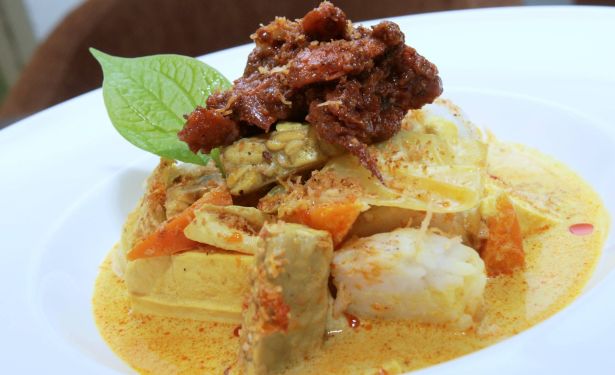Being born in a typical Chinese family in Malaysia, I have decades of experience tasting Chinese New Year dishes, both home-cooked and from restaurant.
As time goes by, I realised the same type of dishes keep appearing on the table during Chinese New Year and I started to wonder why.
That’s when I decided to dig deeper to find the truth behind all these dishes.
Here’s 8 food which commonly make an appearance during Chinese New Year and why they are significant during the festive season in Malaysia.
Note: The content of this article is based solely on the interpretation of the author and folktales passed down from her family.

1.Steamed or Boiled Chicken – It is a customary to almost every Chinese family in Malaysia to have chicken (either steamed or boiled) during Chinese New Year.
The reason is, back in the old days, it is consider a luxury to have chicken meat and therefore, it will only be served during important festivals such as Chinese New Year where everyone in the family comes together.
Hence, eating chicken also symbolizes togetherness.
Although we are able to enjoy chicken meat on a regular basis now, the tradition to serve chicken during new year still stands true for many.
The only difference might be the type of chicken we have during the festive season are more expensive than the regular chicken?
History aside, here’s a few recipes of chicken which you can try for this coming Chinese New Year:
- Fragrant Stewed Chicken
- Steamed Chicken with Chinese Wine
- Steamed Ginger Chicken
- Steamed Herbal Chicken with Red Dates and Ginger

2. Whole Fish – Many of us would have already heard of this idiom 年年有余 (níanníanyoǔyú), which means “to have abundance every year”. As fish
(鱼, yú) in Mandarin have the same pronunciation as “abundance” (余, yú), Chinese families like to serve fish during Chinese New Year as the symbolization.
It is also a tradition to serve a whole fish with head and tail intact as it represents the beginning and the end. The expression tells that ones have to be disciplined and finish everything that one started.
The fish can be steamed or fried, as long as it is served as a whole. Check out these recipes for more ideas:
- Steamed Fish in Tangy Lemon Sauce
- Fried Fish In Chilli Lime Sauce
- Steamed Fish Country-Style
- Deep-fried Fish in Fragrant Sauce
- Thai-Style Steamed Fish

3. Big Prawns – Another common food you will see during Chinese New Year is prawn, the bigger the better.
This is because prawn in Cantonese (har) is similar to the sound of laughter ‘har har’. Therefore, we believe that eating prawn will bring happiness to the family for the whole year.
For the same reason as fish, prawn should be served with its head and tail intact. Here’s a few prawn recipes for you to choose from:

4. Pork Belly – Be it braised or steamed, these jiggly and collagen-rich pork belly somehow made it into the list of the most common food served during Chinese New Year.
There seems to be not much of a significance behind this except pork belly is one of the premium cut of the meat and it usually takes a long time to prepare a pork belly dish.
Hence, it is a grand dish which is usually served during important festival only.
We have picked a few challenging pork belly recipes which you should try for this coming new year:
- Dongpo Rou (Braised Pork Belly)
- Steamed Mui Choy with Pork Belly
- Steamed Five-Spice Pork Belly with Yam

5. Shiitake Mushroom, Sea Cucumber, Abalone – The three musketeers of Chinese New Year dinner menu. Often served as a braised dish, they symbolizes prosperity.
In addition, sea cucumber also represents fertility as the Mandarin for sea cucumber (海参, hǎishēn) has the word ‘shen’ which has similar pronunciation as growth (生, shēng).
Check out these recipes for more inspirations:
- Mushrooms Vegetables with Fried Bean Curd
- Braised Mushrooms With Dried Oysters And Sea-Cucumber
- Abalone Salad

6. Five Spice Meat Rolls (Lor Bak/ Ngo Hiang) – Widely popular in Southeast Asia, this dish is served during Chinese New Year as a symbol of luck because the meat rolls resemble gold bars.
Instead of wrapping in spring roll wrapper, these meat rolls are made with beancurd skin making it crispy on the outside while moist and soft on the inside.
Click here to get the recipe for Lor Bak now!

7. Crispy Roast Pork (Siew Yoke) – Since the Qing Dynasty, it is a customary to served a whole roast pig in court banquets as it is an auspicious sign.
As time goes by, it is being adopted into a Chinese New Year dish and in recent decades, only the roast pork belly is served because it provides the crispiest skin and juiciest part. (Also because a whole pig is too expensive!)
Click here to find out how to make the perfect, crispy siew yoke!

8. Yee Sang/ Yu Sheng – Pop quiz time! When you combine the word ‘Yu’ and ‘Sheng’, what do you get?
Yes, it literally means abundance growth! Hence, eating yee sang during new year represents fortune and luck!
There’s also a saying that the higher you tossed the yee sang, the more fortune will fall to you. So let’s tossed towards a prosperous new year wtih this Gong Xi Fa Cai Yee Sang recipe!
Do you have any Chinese New Year recipe which you would like to share with the Kuali community? You can submit it here!
Also, let us know what are some of your family traditions during Chinese New Year in the comments section below! Happy cooking!







You forgot to mention that one must have the following desserts too:
1) Nian gao or glutinous rice flour cake (Helps stick everyone together)
2) Huat kueh so everybody will “huat” (prosper)
3) Tong yuen (usually on the last day of CNY)
Hey Foon, agreed!